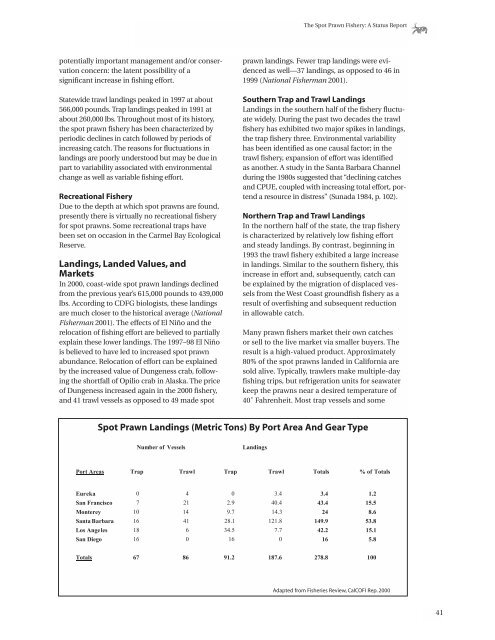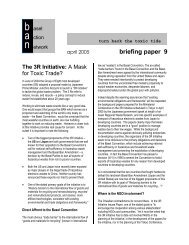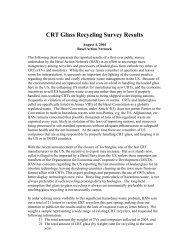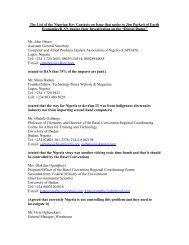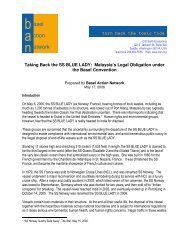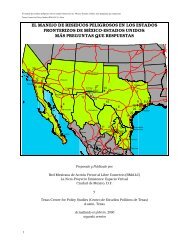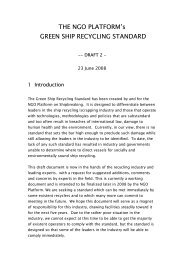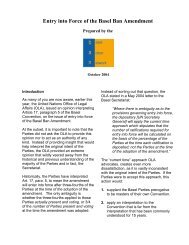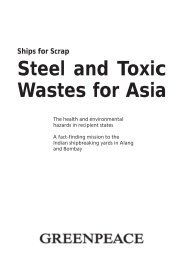The Spot Prawn Fishery The Spot Prawn Fishery - Basel Action ...
The Spot Prawn Fishery The Spot Prawn Fishery - Basel Action ...
The Spot Prawn Fishery The Spot Prawn Fishery - Basel Action ...
Create successful ePaper yourself
Turn your PDF publications into a flip-book with our unique Google optimized e-Paper software.
potentially important management and/or conservation<br />
concern: the latent possibility of a<br />
significant increase in fishing effort.<br />
Statewide trawl landings peaked in 1997 at about<br />
566,000 pounds. Trap landings peaked in 1991 at<br />
about 260,000 lbs. Throughout most of its history,<br />
the spot prawn fishery has been characterized by<br />
periodic declines in catch followed by periods of<br />
increasing catch. <strong>The</strong> reasons for fluctuations in<br />
landings are poorly understood but may be due in<br />
part to variability associated with environmental<br />
change as well as variable fishing effort.<br />
Recreational <strong>Fishery</strong><br />
Due to the depth at which spot prawns are found,<br />
presently there is virtually no recreational fishery<br />
for spot prawns. Some recreational traps have<br />
been set on occasion in the Carmel Bay Ecological<br />
Reserve.<br />
Landings, Landed Values, and<br />
Markets<br />
In 2000, coast-wide spot prawn landings declined<br />
from the previous year’s 615,000 pounds to 439,000<br />
lbs. According to CDFG biologists, these landings<br />
are much closer to the historical average (National<br />
Fisherman 2001). <strong>The</strong> effects of El Niño and the<br />
relocation of fishing effort are believed to partially<br />
explain these lower landings. <strong>The</strong> 1997–98 El Niño<br />
is believed to have led to increased spot prawn<br />
abundance. Relocation of effort can be explained<br />
by the increased value of Dungeness crab, following<br />
the shortfall of Opilio crab in Alaska. <strong>The</strong> price<br />
of Dungeness increased again in the 2000 fishery,<br />
and 41 trawl vessels as opposed to 49 made spot<br />
<strong>The</strong> <strong>Spot</strong> <strong>Prawn</strong> <strong>Fishery</strong>: A Status Report<br />
prawn landings. Fewer trap landings were evidenced<br />
as well—37 landings, as opposed to 46 in<br />
1999 (National Fisherman 2001).<br />
Southern Trap and Trawl Landings<br />
Landings in the southern half of the fishery fluctuate<br />
widely. During the past two decades the trawl<br />
fishery has exhibited two major spikes in landings,<br />
the trap fishery three. Environmental variability<br />
has been identified as one causal factor; in the<br />
trawl fishery, expansion of effort was identified<br />
as another. A study in the Santa Barbara Channel<br />
during the 1980s suggested that “declining catches<br />
and CPUE, coupled with increasing total effort, portend<br />
a resource in distress” (Sunada 1984, p. 102).<br />
Northern Trap and Trawl Landings<br />
In the northern half of the state, the trap fishery<br />
is characterized by relatively low fishing effort<br />
and steady landings. By contrast, beginning in<br />
1993 the trawl fishery exhibited a large increase<br />
in landings. Similar to the southern fishery, this<br />
increase in effort and, subsequently, catch can<br />
be explained by the migration of displaced vessels<br />
from the West Coast groundfish fishery as a<br />
result of overfishing and subsequent reduction<br />
in allowable catch.<br />
Many prawn fishers market their own catches<br />
or sell to the live market via smaller buyers. <strong>The</strong><br />
result is a high-valued product. Approximately<br />
80% of the spot prawns landed in California are<br />
sold alive. Typically, trawlers make multiple-day<br />
fishing trips, but refrigeration units for seawater<br />
keep the prawns near a desired temperature of<br />
40˚ Fahrenheit. Most trap vessels and some<br />
<strong>Spot</strong> <strong>Prawn</strong> Landings (Metric Tons) By Port Area And Gear Type<br />
Adapted from Fisheries Review, CalCOFI Rep. 2000<br />
41


